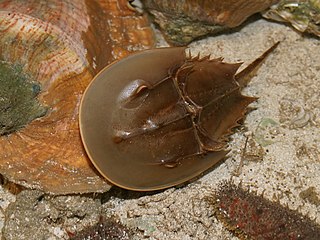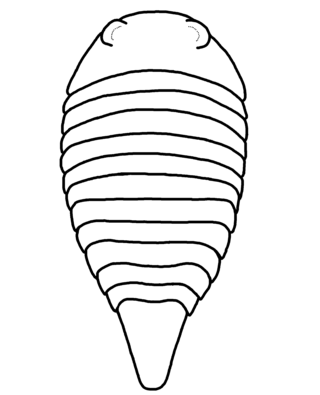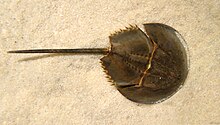
The subphylum Chelicerata constitutes one of the major subdivisions of the phylum Arthropoda. It contains the sea spiders, horseshoe crabs, and arachnids, as well as a number of extinct lineages, such as the eurypterids and chasmataspidids.

Amplexus is a type of mating behavior exhibited by some externally fertilizing species in which a male grasps a female with his front legs as part of the mating process, and at the same time or with some time delay, he fertilizes the eggs, as they are released from the female's body. In amphibians, females may be grasped by the head, waist, or armpits, and the type of amplexus is characteristic of some taxonomic groups.

The Atlantic horseshoe crab, also known as the American horseshoe crab, is a species of horseshoe crab, a kind of marine and brackish chelicerate arthropod. It is found in the Gulf of Mexico and along the Atlantic coast of North America. The main area of annual migration is Delaware Bay along the South Jersey Delaware Bayshore.

Eurypterus is an extinct genus of eurypterid, a group of organisms commonly called "sea scorpions". The genus lived during the Silurian period, from around 432 to 418 million years ago. Eurypterus is by far the most well-studied and well-known eurypterid. Eurypterus fossil specimens probably represent more than 95% of all known eurypterid specimens.

Horseshoe crabs are marine and brackish water arthropods of the family Limulidae and the only living members of the order Xiphosura. Despite their name, they are not true crabs or crustaceans: they are chelicerates, most closely related to arachnids such as spiders, ticks, and scorpions.

Xiphosura is an order of arthropods related to arachnids. They are more commonly known as horseshoe crabs. They first appeared in the Hirnantian. Currently, there are only four living species. Xiphosura contains one suborder, Xiphosurida, and several stem-genera.

Slimonia is a genus of eurypterid, an extinct group of aquatic arthropods. Fossils of Slimonia have been discovered in deposits of Silurian age in South America and Europe. Classified as part of the family Slimonidae alongside the related Salteropterus, the genus contains three valid species, S. acuminata from Lesmahagow, Scotland, S. boliviana from Cochabamba, Bolivia and S. dubia from the Pentland Hills of Scotland and one dubious species, S. stylops, from Herefordshire, England. The generic name is derived from and honors Robert Slimon, a fossil collector and surgeon from Lesmahagow.

Tachypleus is a genus of south, southeast and east Asian horseshoe crabs in the family Limulidae.

Tachypleus tridentatus, commonly known as the Chinese horseshoe crab, Japanese horseshoe crab, or tri-spine horseshoe crab, is a species of horseshoe crab found in Southeast and East Asia, with records from China, Indonesia, Japan, South Korea, Malaysia, the Philippines, Taiwan, and Vietnam. It is found in coastal marine and brackish waters, and tolerates colder temperatures than the other Asian horseshoe crabs, although juveniles still need water warmer than 22 °C (72 °F) to moult.

Mixopterus is a genus of eurypterid, an extinct group of aquatic arthropods. Fossils of Mixopterus have been discovered in deposits from Late Silurian age, and have been referred to several different species. Fossils have been recovered from two continents; Europe and North America.

Onychopterella is a genus of predatory eurypterid, an extinct group of aquatic arthropods. Fossils of Onychopterella have been discovered in deposits from the Late Ordovician to the Late Silurian. The genus contains three species: O. kokomoensis, the type species, from the Early Pridoli epoch of Indiana; O. pumilus, from the Early Llandovery epoch of Illinois, both from the United States; and O. augusti, from the Late Hirnantian to Early Rhuddanian stages of South Africa.

Legrandella is a genus of synziphosurine, a paraphyletic group of fossil chelicerate arthropods. Legrandella was regarded as part of the clade Prosomapoda. Fossils of the single and type species, L. lombardii, have been discovered in deposits of the Devonian period in Cochabamba, Bolivia.

Pasternakevia is a genus of synziphosurine, a paraphyletic group of fossil chelicerate arthropods. Pasternakevia was regarded as part of the clade Planaterga. Fossils of the single and type species, P. podolica, have been discovered in deposits of the Silurian period in Podolia, Ukraine.

Weinbergina is a genus of synziphosurine, a paraphyletic group of fossil chelicerate arthropods. Fossils of the single and type species, W. opitzi, have been discovered in deposits of the Devonian period in the Hunsrück Slate, Germany.

Tachypleus gigas, commonly known as the Indo-Pacific horseshoe crab, Indonesian horseshoe crab, Indian horseshoe crab, or southern horseshoe crab, is one of the four extant (living) species of horseshoe crab. It is found in coastal water in South and Southeast Asia at depths to 40 m (130 ft).

Slimonidae is a family of eurypterids, an extinct group of aquatic arthropods. Slimonids were members of the superfamily Pterygotioidea and the family most closely related to the derived pterygotid eurypterids, which are famous for their cheliceral claws and great size. Many characteristics of the Slimonidae, such as their flattened and expanded telsons, support a close relationship between the two groups.

Paleomerus is a genus of strabopid, a group of extinct arthropods. It has been found in deposits from the Cambrian period. It is classified in the family Strabopidae of the monotypic order Strabopida. It contains two species, P. hamiltoni from Sweden and P. makowskii from Poland. The generic name is composed by the Ancient Greek words παλαιός (palaiós), meaning "ancient", and μέρος (méros), meaning "part".

Armases cinereum, also known as the squareback marsh crab or wharf crab, is a species of crab in the family Sesarmidae. The wharf crab is a small crab that is dark brown to muddy in color, which allows it to blend in with its usual surroundings. It is found on the Atlantic southeastern coast, down into the Gulf of Mexico. It is an omnivore and is prevalent in marshy coastal environments along the Southwestern Atlantic.

Camanchia is a genus of synziphosurine, a paraphyletic group of fossil chelicerate arthropods. Camanchia was regarded as part of the clade Prosomapoda. Fossils of the single and type species, C. grovensis, have been discovered in deposits of the Silurian period in Iowa, in the United States. Alongside Venustulus, Camanchia is one of the only Silurian synziphosurine with fossil showing evidence of appendages.



















